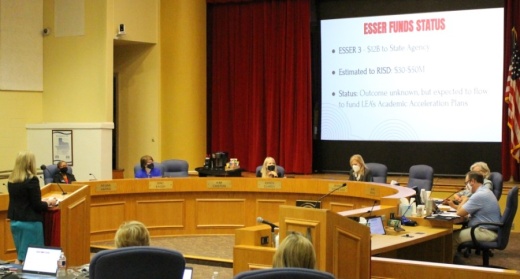"It's been [said to be] as high as $75 million that we could be receiving," Superintendent Jeannie Stone said. "Now is the time for us to be ready to invest in our district, in our students and recovering from what has been a very difficult year and a half."
Texas public schools were allotted $1.3 billion in the first round of Elementary and Secondary School Emergency Relief Fund. In an April 14 presentation to the State Board of Education, Commissioner of Education Mike Morath said those funds were used to fund hold harmless in the 2019-20 school year. The hold harmless provision ensured school districts received state funding based on their projected enrollment despite attendance declines, potentially preventing teacher layoffs and other budget cuts, he said.
The second and third rounds of ESSER funding, amounting respectively to $5.5 billion and $12.4 billion, have not yet been distributed to Texas public school districts. Morath said this is because the Legislature is awaiting guidance from the federal government on certain conditions tied to the funding.
"There's no information to us right now as to when that we would be receiving these dollars, although we are needing and expected to plan for our acceleration plans for the summer and for the upcoming year," Stone said.
RISD's academic acceleration plan includes one-time expenses of $4.1 million and a two-year recurring cost of $28.22 million per year.
"We have been standing up in front of you, really since August, sharing with you ... the very real learning loss that our students have experienced," Deputy Superintendent Tabitha Branum said to the RISD board. "We know on average, our students in reading are seeing a three-to-five month learning gap. And our students in mathematics are seeing a four-to-six month learning gap."
The district's plan includes funds for summer intervention and enrichment, an expansion of the district intervention team, student and teacher support and more.
According to the two most recent rounds of ESSER funding, states are required to maintain the same percentage of funding to support education allocated prior to the pandemic through fiscal year 2022-23. Morath said Texas faces a unique challenge here because House Bill 3 passed in 2019 infused a net $4.4 billion of new revenue year over year into school district budgets in FY 2019-20.
Morath said he is optimistic a resolution will be reached soon, and districts will be given clarity regarding this federal funding.
“The legislative leadership is actually very interested in making sure that all districts are made whole in their COVID expenses,” Morath said.
Stone said she is hopeful the district will receive the money from the third round of ESSER funding, which is estimated to be $30 million-$50 million for RISD. However, she said the district is not banking on receiving anything from the second round of ESSER funding.
"In the absence of any ESSER funds, which is highly unlikely, then we would go to our budgets [for alternative funding for the academic acceleration plan]," Stone said. "We would look at the sources that we already have in reserve, potentially for some or all of this."





